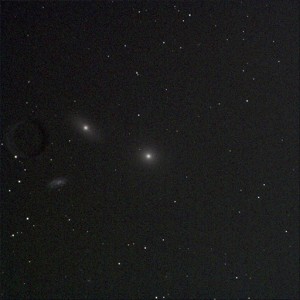Last night (Saturday, May 23, 2020) was a beautiful dark clear night in Monrovia. Tonight is forecast to be even better and warmer. I can’t resist! When will I sleep?
By the end of evening twilight, I was aligned, focused, calibrated, synced, and ready to image.
I’ve been cherry picking Messier objects that were near their highest altitude for the evening. There’s a trio of galaxies near each other in Leo, M95, M96, and M105. I thought I’d start with these.
This is where I discovered the real weakness of urban astrophotography. For M95 and M96, I could not find a guide star anywhere nearby. I took a couple of images only to have the guiding software (PHD2) hunting around and guiding on what it thought were stars. The results were all squiggly lines. So I mostly gave up on those two for tonight.
I had better luck with M105, and got a nice image of it with two nearby NGC objects.
But wait, there’s an interesting detail. You might not see it if you’re in a bright room, or with a bright background. You might click on the image for the full resolution version.
Do you see that odd circle in the background, left center?
That’s nothing mystical, it’s just caused by a mote of dust on the imaging glass of my camera. The mote is “out of focus” so it appears as a shaded circle. I correct for those by taking a series of flat images at the end of the night. I point the telescope at the zenith and put a light panel on top of the scope. I calibrate the timing so it generates a flat grey image around 50% of the camera’s dynamic range. (I’ll take a picture of that process tonight to show you.)
Here’s the flat from last night’s imaging run, stretched in contrast so the differences show a little more:
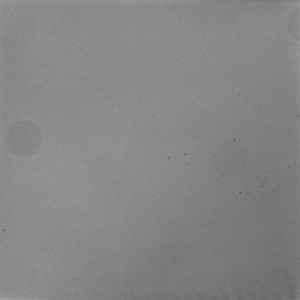
Flat image taken after the observing run. notice the darker circles from dust specks, and possibly vignetting from the telescope.
I didn’t shoot flats for years because I couldn’t figure out how to get a neutral grey image target in the field, and calibrate it for a 50% image. Now that’s handled by my light panel and software that calculates the right image duration.
You can see the dark circle on the flat that matches up with the circle in the background of the M105 image. That leaves a mystery — why didn’t the flat correct for the dust mote, like it usually does?
As a test, I recalibrated the image without the flat, and the circle was still there, but it didn’t have the “3D” look to it from the calibrated image.
You can see the same problem in two other images from last night:
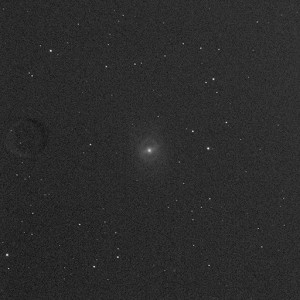
M95 in Leo, I only captured 10 minutes of exposure time on this for failure to find good guide stars, but I saved the image anyway. I’ll revisit soon.
Look, there it is again — that dust mote circle in the left center of the image.
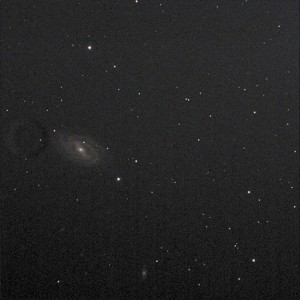
M109 in Ursa Major. I had to shift the galaxy out of the center of the frame so I could find a star reliable enough to guide on.
And yet again, there’s the circle just to the left of M109.
Now here’s the last image from last night. Under the circumstances, I thought this was a beautiful shot of M63 the “Sunflower” galaxy.
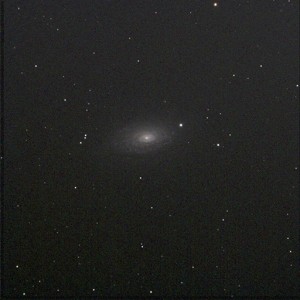
M63 the Sunflower galaxy. Click for full resolution. The dark band on the left is an artifact of registering the sub-exposures. I need to crop the image.
Wait, where did the dust circle go? It’s not there! The flat worked perfectly for my M63 image.
That mystery dust circle was a puzzle as I was processing the images in the wee hours of Sunday. When I saw this last one, I understood what happened. Can you guess?
I always shoot my flats at the end of the evening. It’s that one dreaded task I have to do before packing up the gear in the wee hours. It has to be done while it’s still dark.
The flat worked perfectly for my last image. It could only mean one thing:
The dust mote that made the circle shifted position during all the telescope movements during the evening.
During the early evening exposures, it was in a slightly different spot on the glass cover than it was during the last image. You can see the effect — the flat compensation shows extra bright on one side, and extra dark on the other. That’s what gives it the “3D” raised, or depressed, effect.

